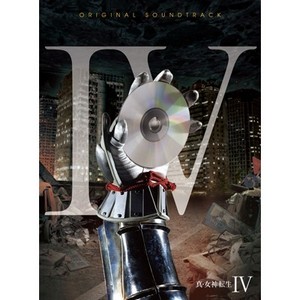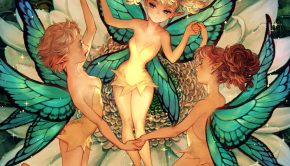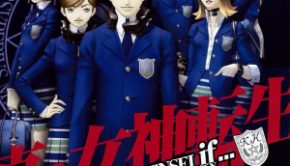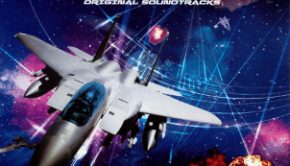Shin Megami Tensei IV Original Soundtrack
 |
Album Title: Shin Megami Tensei IV Original Soundtrack |
| Record Label: Index Corporation |
|
| Catalog No.: LNCM-1043/6 |
|
| Release Date: February 26, 2014 |
|
| Purchase: Buy at CDJapan |
Overview
Some days are Super Mario kind of days. Some days are not. Shin Megami Tensei IV is there for you on days that are not. The original soundtrack for this epic Nintendo 3DS game spans a 4-disc collection with over 4 hours of demon music to swing a samurai sword to. Each track is a scene of its own holding a different memory and smell. Not every track is a goldmine or a hit single, but there are plenty of stand-alone tracks a fan might want to tune in to every so often. The soundtrack isn’t exactly accessible: There are some tracks that some listeners may deem as noise, and some might argue that there are ‘wrong notes’ and ‘odd tuning’ all over the release. But I do not believe these ‘wrong notes’ are accidents; the dissonance throughout the release is meant to portray the bizarre and sometimes confusing atmosphere of the game. If you plan to use this music to attempt to fall sleep, I hope you’re prepared to have nightmares beyond your wildest imaginations. In fact, stay awake and listen closely because the Shin Megami Tensei IV Original Soundtrack will definitely take you places.
Body
The “Main Theme” is one of the most eerie sounding opening themes I have heard in any video game I have ever played. A rather dissonant and angry chord is hammered out in the pits of the low end of the piano to let the listener know this isn’t any joy ride of a JRPG. A hip-hop inspired beat slowly creeps up on you and soon a Mellotron-sounding instrument sings a fragment of a melody while a synth-bass drones on with a counter melody. Composer Ryota Koduka offers a short-lived synth solo that I will never forget, but wouldn’t necessarily sing if I was in a good mood.
The disc then slowly guides you down a hall that seems to have rooms off to the sides with more and more frightening music filled with dark and dismal ambience. Tracks like “Hallucination” and “Premonition” remind me of the dark presence the band Tool creates. The scraping metal sounds and weird textures are enough to make your heart sink. The former is a modern reimagining of the classic sounds that Tsukasa Masuko built for the series. The music of “Homesickness” and “The Kingdom of Mikado” stands out because there are no elements of electronic instruments, or so it seems. There is what sounds like string instruments and flutes as well as some snare drums and a bass drum, and there is even a marimba feature in “Homesickness”. However, there is something unnatural about the performance and timbre of the instruments that represent the questionable nature of Mikado while playing the game. Fans new and old of the Megaten series can decide for themselves which track was created with either law or chaos as a motive. Some tracks are certainly neutral, but it really depends on the listener’s interpretation.
For those unfamiliar with this game, the point is to collect, fuse and battle demons. Maybe it is because of my rock n’ roll background, but I found the battle music to be the most enjoyable and memorable music of the game and soundtrack alike. Tracks “Battle A-1”, “B-1” and “B-2” drew me into the battle scenes with their fast aggressive tempi and groovy bass lines. The drums are on top of the beat and have a punk and metal influence all at the same time. The guitar is distorted and run through a few phaser and reverb effects while the melody trades off with either synth or organ modeling. The battles in the game are numerous and sometimes too much to handle. The music, however, makes the monotony of demon slaying less of a grind. There is battle music on each disc that breaks up the lucid sounding grouping of pieces in this soundtrack. For some relief, “Battle Over” is played after a battle and is heard no matter how well you fought or what kind of loot you receive or even if you collected a demon for personal use. The listener can make out a faint beat and a brilliant choir to relax a battle-hardened soul.
If you aren’t a fan of metal or punk, don’t worry. There are still more doors down this dark hallway that contain all kinds of music you might even want to dance to. The soundtrack takes many twists and turns and borrows influences from many different kinds of music from all over the world. The music flip flops in disc one quite a bit from a strange modern Baroque feel heard in “Ks Tavern” to a horror movie sounding ambiance in “Naraku: Upper Strata” and “Naraku: Lower Strata”. “Traffic” is one of those tracks that is funky but forlorn at the same time. While the “Kingdom of Mikado” has a classical stately manner to it, ‘Traffic’ sounds like a dance party in a hip bar. The fuzzed-out bass line reminds me of classic video game scenes from the Super Nintendo days. Earthbound comes to mind while listening to “Traffic”, only to be swept back into the halls of Shin Megami Tensei with a collection of five organ solos.
These organ solos represent and say so much about the Shin Megami Tensei series. The classic sound of the organ brings to mind the eerie image of a massive Gothic church and masolieums in a graveyard. Fusing demons to make a new and more powerful monster would be my last thought before playing these games. But the creepy and sinister nature of the organ pieces put me in the right mood to mix and match those demons. The first time I heard organs was either in Soul Blazer for the Super Nintendo or the interlude in “Won’t Get Fooled Again” by The Who. I was very young and the organ’s large sound rattled my entire being and enchanted me. But the organ music in Shin Megami Tensei IV is much more dark and sinister but still was able to spark my imagination. Adding to the nostalgia, several of these tracks are in fact arrangements from the Super Nintendo originals of the series.
Upon popping in the next disc the listener is taken to a post apocalyptic scene of Tokyo. The streets are empty and littered with trash and the demons that inhabit the streets are looking to take your money, items, soul and your life. The first track entitled “Tokyo” is what is heard while traversing the overworld in the game. Because every track is different there truly is a lot to discover and take in. Disc 2 of the soundtrack has a mix of hard techno inspired drumbeats with thumping electric bass lines like that of disc one. There are ambient and dark chords layered on top of shrill effected voices when traversing the streets of Ikebukuro or Shinjuku. After you find your way to a subway and a bar, a lonely club sounding jam will accompany your rest and recovery, while playing the game of course.
I almost can’t help but go into more detail about the battle and boss music because of how it reminds me of countless boss battles I have faced in my years of video gaming. Megaten battle music encompasses all the best aspects of why I love to play the games and why I love the music in them. The blend of action-packed drum beats, metal inspired guitar riffs, and pitch-bending synth solos makes the music perfect for slaying demons. The music in some of the Underground Districts had an old and uncomfortable feeling, like I was trapped in a place where I just didn’t belong with people I just couldn’t understand. The music simply made me want to go back to demon slaying to hear those calculated and smooth as butter guitar riffs.
Amid the haunting sounds of scraping metal and dissonant piano melodies, there are a few R&B influenced beats and bass lines mixed in this soundtrack. “The Ashura-Kai Authorized Shop” certainly has a modern feel that could be in a Hollywood movie or even on a college radio station. It is some of the most familiar sounding music, the closest in my opinion to western influenced pop music like Pretty Lights or STS9. Interestingly this could be saying something about who the Ashura-Kai are in the game, or just that the music is meant to represent a modern feeling. Even the ‘Black Market’ has a modern feel with an Eastern sounding string instrument playing the melody in the beginning. There is something in the melody that doesn’t resolve and leaves me with the feeling like something is missing.
While the notion of law and chaos lingers on a player’s mind while slaying and collecting demons in a SMT game, the “Chaos Theme” is rather controlled and not quite what I would expect from a piece entitled “Chaos”. The music crescendos into a mezzo forte dynamic and stays there and seems to smirk as that choir sings out a haunting melody. The string bass hangs onto a deliberate and forceful ostinato pattern while the choir and brass make their entrances. I believe the chaos angle of this track is that there is an uncertainty of what will happen next. There is a sense of mystery to “Chaos Theme” that makes it sound ‘evil’. By the end of disc two I was glued to my seat and my hair was blown back. I felt weird and my head was kind of spinning from the various moods and genres I had experienced in the first half of the soundtrack. My first listen through, I was apprehensive about what I would hear in discs 3 and 4. How much heavier and intense could the battle music get? What door in this dreary hallway should we open next?
For one, “The River Styx” took me back to my college days while I participated in my school’s percussion ensemble. The pitched gongs gave an eerie sound to the music almost as if underwater. The swells of drum rolls and china cymbals created a heavy ambiance that seemed to breath a dark energy into the room. It set the tone for the rest of this musical journey. Again, the soundtrack twists and starts to groove. As in other similar tracks, the bass lines in “Challenge” are prominent while the drums take a back seat. The melodies in this groove are hooky, but not happy. They provide the game with a unique style of action and sometimes a quirky atmosphere. These dance inspired pieces are sometimes suspenseful and tend to be written in strange modes and minor key signatures. “Club Milton” sounds like a haunted dance party with ghosts having a grand old time. The bass drum sounds muffled as if I were outside the ‘club’. This creates such a strange, uncomfortable ambiance. I wouldn’t want to linger in these bars or clubs for too long, that’s for sure.
Between all the intensity, there are some moments of clarity. “Charon” is one of the more serene pieces that sounds like it could be orchestrated for a string ensemble. However, the ether is broken by the aforementioned Challenge Quest music. “Café Florida” stands out to me so much while listening to this soundtrack. It has a sultry and human sound that is unique to the computerized voices and programmed drum beats. The melody is certainly bluesy and minor in quality, which adds to the dramatic way in which the piano was recorded. The piano seems to be run through a wall of compression and possibly some reverb. The piano just sounds so far away as if in another room. It is a rather short interlude and the ear is jarred by ‘Tokyo Midtown’, and it is time for another break beat style jam.
The time has come for the ‘Law Theme’ at almost 2 hours and 30 minutes into this epic work. Trust me, it’s no time at all compared to what some players will and have already spent in the game. “Law Theme” in this game offers another chance to breathe and listen to something familiar sounding. The choir sounds natural and balanced. Faint timpani hits provide an omen or a sign that there is something more to the mournful choir music. “Law Theme” seems to bleed into the next track, “Separation”, which carries the same dreamy tone. These serene and expressive pieces of music are short lived and almost lost in the mix with 80’s inspired dance tracks and heavy metal sounding battle music. “The White”, on the other hand, is a strange track that has a duality and two-facedness about it that pulls the ear in two different directions. If you could hold music up to a mirror, “The White” would be a prime example of that effect. It sounds as if there are two of each note being played slightly out of tune but perfectly in time. It is almost painful to listen to as it blurs the line between music and noise.
Music has the incredible power to make a listener think, and even jump to conclusions. The “Law [origin]” compared to “Chaos [origin]”, both arrangements of the Shin Megami Tensei classics, makes me wonder what law and chaos are in the game. “Chaos” does not seem to be chaotic musically. It is written in common time and does not seem to have any misplaced or harsh notes. The timbre of “Chaos” is rather electronic and reminiscent of natural sounding instruments like the flute and violin. “Law” on the other hand doesn’t seem to be much different in nature than “Chaos”. The timbre of the instruments is still electronic but resembles acoustic voice and piano. I suppose “Law” sounds more stately and subdued than “Chaos”. The two pieces of music are very similar to an outside perspective and speak volumes to one’s perception of the differences and similarities between the notion of law and chaos.
Moving to the beginning of the end, the series of ‘Infernal’ pieces are the end of a storm before a different kind of battle music starts to invade the soundtrack. “Infernal Tokyo: Underground District” sounds like a familiar dub track I might have heard on an independent internet radio station. This music sounds influenced by traditional Japanese melodies played on a Shamisen. The blend of Western influenced beats and Eastern influenced melodies and timbres provides a familiar video game experience I know and love. “Monochrome Forest” does not hold your hand as it leads you down a dark and dank path. The first noise that is heard here is what sounds like a few coins being scraped on the strings of a grand piano. The prepared sound is repeated while moans and creaks come in and out of focus. I believe “Monochrome Forest” is foreshadowing to what is to come on the climactic disc.
In my opinion, the “Neutral Theme” blends the natural sounding voices of the “Law Theme” and the electronic sounding instruments of the “Chaos Theme”. I believe the chord progressions of each theme does not resolve and repeats in such a way that is very incomplete to the ear. I feel there are too many similarities in the notes and chord structure to differentiate between what each theme could mean.
The battle music takes on a theme of its own on disc 4. Although it does not sound like the youthful and edgy “Battle A-1” music, the battle music of disc 4 has a sense of maturity and wisdom about it. The music starts to sound more like an orchestra performing live as opposed to a warped interpretation of what orchestral instruments might sound like. Rather than a thrash metal style instrumental, “Battle-B4” takes on a more progressive and mature feel. ‘B4’ reminds me of Mike Oldfield’s compositions that have been inspired by classical music. The rhythm section remains tight and lively while a chime riff is hammered out in a foreign sounding key signature. “Pergatorium” retains the same broad and grave tone to “Battle B-5” and “Battle B-6”.
The intensity is built in “King”, with a crescendoing orchestra lick that gets just loud enough to hear then disappears before ‘Reign’ imposes its thick chorus of male voices. These tracks with “Lucifer Palace” included help keep the soundtrack’s broad and monstrous tone. The game constantly feels as though it is at an end but pushes the player to fight beyond known limits. The energy and passion up to this point in the soundtrack reflect the emotion and drive was put into making the game and what it will take to beat the game.
When the music of “Battle B-6” seems to beat you down with its industrial timbre, the sweet melodies of “Mission” and “Messiah” will help you relax before the long haul to the end. These pieces are short and orchestral in nature. “Messiah” sets a tone that just doesn’t seem to last while listening to this soundtrack. The bright chords and major chord progressions stand out amongst the angry and frustrated sounding harmonies and noises of “Masakado”. But by the time “Masakado” is heard the listener is weary and apprehensive of when the music will put a smile on his or her face. If “Shop” doesn’t put a smile on your face and a tap in your toe, then find a different 3DS game to enjoy. If you have gotten to this point it is about rounding out the experience with something memorable, something to take away from the music that will leave a lasting impression.
For one last round, “Battle C-5” and “C-6” are two tracks that epitomize the feelings and emotions felt when fighting to finish the game and soundtrack alike, the former a remix, the latter an original. The energy or pulse never fades and the listener’s adrenaline is driven by tense synth riffs. Familiar chime and gong sounds have been run through phasers and processed for that unique Megaten sound. The intensity is created by the constant changes and unpredictable notes and sounds. A large sounding string orchestra, similar to what you would hear in a Mahler Symphony, is what is to be expected at the conclusion of such an expansive and epic soundtrack.
“End Credits” is a sad goodbye to such an incredible composition and collection of expertly composed video game music. The moderate tempo accompanies the melancholy bass line. The pulsing beat is a strong foundation while you journey through familiar themes from the soundtrack. Usually I feel like I’ve accomplished a great deal by listening to a soundtrack in its entirety. I feel the same by completing a game of this breadth. Shin Megami Tensei IV makes me feel as though I’m still stuck in a demon infested land of Tokyo, that I’ve lost so much time searching for a common theme in this chaotic mix of classical, metal and pop music. I won’t ask for deeper meanings in the themes of ‘law’ and ‘chaos’ or why the final track is 13 seconds of a very secretive and mysterious synth chord.
Summary
Nothing in game music history can come close to the diverse genres and attention to detail on this album. The music so accurately expresses every emotion expressed while peeking down a dangerous alley in Tokyo. The soundtrack is successful in separating itself from most other video game music by being angry, energetic relentless and unaffected by public opinion. One should sit back and enjoy what he can of this soundtrack. The music goes perfectly with the art style and twitch reaction gameplay. Like I said before, some days are just not Super Mario days. Pick up this soundtrack when you need an evil sounding voice in your head.
Do you agree with the review and score? Let us know in the comments below!
4.5
Posted on August 11, 2014 by Marc Chait. Last modified on August 11, 2014.














